How to drain water from a water heater to preserve the water supply system
In country or country houses that are not used for living during the cold season, care must be taken in advance to prepare all engineering systems for winter. It is necessary to completely empty the water supply and heating circuits of water. This also applies to water heating devices.
We will tell you how to drain water from a water heater quickly and accurately, and in what sequence the work to preserve the systems is carried out. We describe in detail all the options and methods for removing water from equipment. Rules for disassembling equipment that must be followed are given.
We supplemented the information presented for review with visual diagrams and illustrations, step-by-step photo guides and video instructions.
The content of the article:
Reasons for draining water
The problem of preserving the water supply system is relevant if the temperature in the room can drop to +5 °C and below.
Freezing temperatures will cause the liquid in the pipes and tank to freeze, which can lead to ruptures and damage to the water heater and piping.
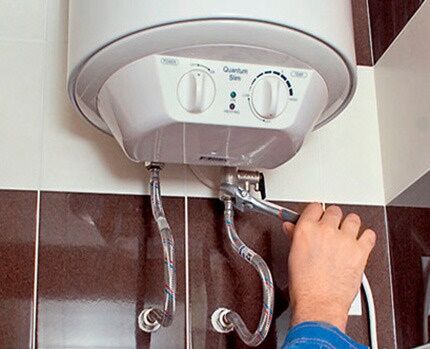
Some manufacturers do not recommend leaving the device without water for a long time without a good reason, since corrosion occurs much faster when in contact with oxygen. But if the device is stored at sub-zero temperatures, all water from the system must be drained.
Even storage water heater - boiler - Used all year round, it still needs to be cleaned periodically. This is done once or twice a year, depending on the quality of the water. In addition to the fact that during operation, dirt and bacteria accumulate (and even legionella, causing inflammation of the lungs), a scale forms that covers heating element and the inner walls of the container.
Scale settling on the heating elemente, works as a thermal insulator. The longer the water heater is not cleaned, the thicker the insulating layer it is covered with. Because of this, over time the device heats more of itself than it processes water. If the heating element is dirty, electricity consumption increases by 25-50%.
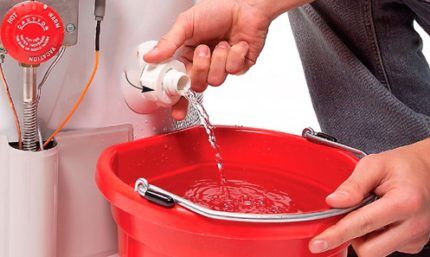
A number of manufacturers indicate in the documentation for the heating unit that, for preventive purposes, draining a small amount of water through the drain tube should be carried out at least once a month. This is done to remove limescale deposits and control the perfect operation of the valve (tap).
For removing water from water heating equipment There are a number of standard prerequisites:
Signs that indicate it’s time for immediate cleaning:
- The water pressure became weaker;
- The water took longer to warm up;
- The device began to make an unusual noise;
- Water drips from the safety valve very often or does not drip at all;
- It's time for scheduled preventative cleaning.
The need to empty the boiler of its contents may also arise in the event of a breakdown or when replacing the heating element.A or magnesium anode. In all of the above cases, water is drained from the unit according to a similar scheme.
If the water in the tank is simply stagnant and emits an unpleasant odor, just open the tap and drain the water for some time to replace it with fresh water. After this, turn on maximum heat. The procedure must be repeated if necessary a third time, etc. This will kill all pathogenic microflora.
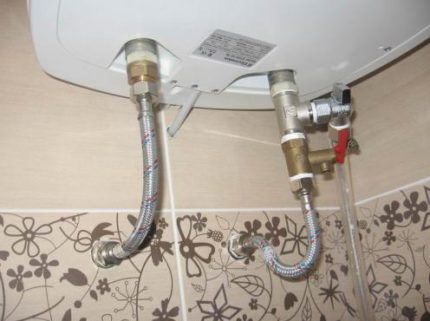
Water heater release procedure
Although draining water from an electric water heater is considered a routine procedure designed to extend the life of the electrical appliance, it is still better to carefully study the instructions.Each brand or model may have significant differences, so it is better to study all the nuances in advance.

Sometimes the manufacturer absolutely does not allow anyone who is not a service representative to interfere with the operation of the device until the warranty period has expired. Complex heating devices should not be disassembled yourself to completely drain the water, so as not to be damaged by incorrect actions.
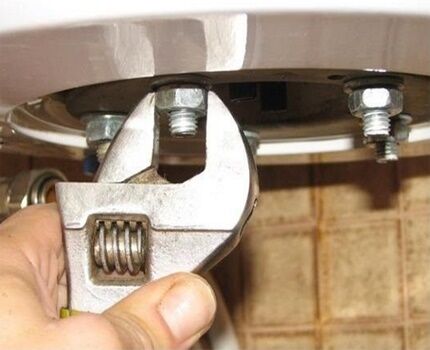
If you need to disassemble the boiler piping, you cannot do without a set of tools.
Tools you may need:
- 4 mm hexagon;
- adjustable wrench (you can take a gas wrench No. 2);
- rubber hose of suitable diameter;
- straight and Phillips screwdrivers.
Also prepare a container if the boiler is not hanging above the bathtub and water from the heater may spill onto the floor.
Before starting work, you must make sure that:
- The water heater is disconnected from the power supply.
- The cold water supply tap is closed.
- The temperature in the container has dropped to safe values.
You can speed up cooling by turning off the heating mode and flushing some hot water to dilute it with cold.
Draining water from electric water heating equipment is carried out in the standard sequence:
Accounting for the water heater device
There are videos on the Internet in which “craftsmen” attach a hose and unscrew the drain valve and wait for water to miraculously flow out of the closed system. In order for your actions to be conscious, you need to familiarize yourself with water heater operating rules, its structure and principle of operation.
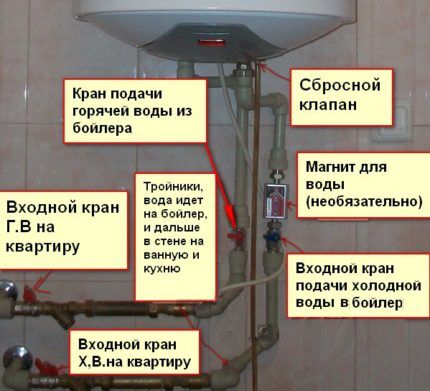
Water heater device:
- Internal tank.
- Thermal insulation.
- External decorative body.
- Control sensor.
- Electrical cable.
- Temperature sensor.
- Output of heated water.
- Magnesium anode. Protects against rust formation, neutralizes the effects of corrosion. Requires replacement every two years.
- heating element - a heating element. It is made mainly from a nichrome spiral wrapped in a copper casing, which promotes rapid heating of water.
- Flux absorber. Prevents layers of cold and warm water from mixing (keeps cold water at the bottom). Thus, cold currents, without mixing with hot ones, remain below, and hot ones remain above. This allows you to continuously use warm water while simultaneously more water from the system.
- Temperature regulator. Helps set the heating temperature to 75 °C and fix it at a comfortable value. At a temperature of 85-95 °C, automatic shutdown occurs.
- Water intake tube from the water supply system.
Since the pipe for supplying water to the water heater is located at the bottom, water can only be drained through it. Why this is so can be understood by looking at the diagram. On water heaters of any manufacturer, the inlet and outlet are marked. There is a blue gasket on the water supply pipe, and a red gasket on the outlet pipe.
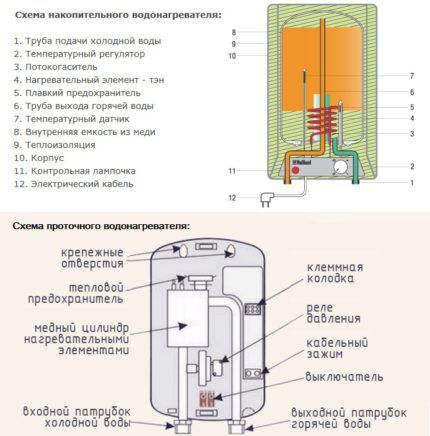
Standard connection (with tee)
This is a connection recommended by manufacturers, in which a tee with a tap is installed on the pipe section from the device to the safety valve. To drain water from such a system, no tools are needed.
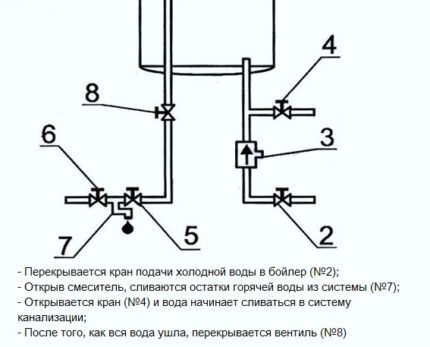
Standard connection diagram:
- Water heater.
- Water supply tap to the boiler.
- Safety valve.It is installed to prevent water from flowing back when there is no water in the system.
- Tee with drain tap.
- Mixer tap for hot water supply.
- Cold water tap.
- Mixer.
- Shut-off valve. Stops the drain of hot water from the appliance.
If the water heating unit is connected correctly, then draining water from its tank will take no more than 10 minutes.
Step by step draining water from a water heater can be described as follows:
- The device is unplugged from the socket and the water supply to the water heater (2) is shut off.
- Open the hot water valve (5), and drain the liquid from the tube through the mixer (7). The tap (5) is left open - air will flow into the system through it.
- Put on the drain hose, open the drain valve (4) and drain the water.
- As soon as the water has gone, close the shut-off valve (8).
The procedure may take several hours. You can speed it up only by removing the hose from the cold water intake pipe, thereby increasing the size of the stream.
The reason for a long drain may be poor air flow into the system through the mixer. The situation can be corrected either by removing the hose from the pipe for discharging hot water, or by connecting a pump (compressor) to the hose, with which to pump air into the system.
To start the water heater, you must close the valve to hot water pipe (5) and drain tap (4), open access to cold water (2) to the device. The boiler can only be plugged in after it is completely filled.
The system can be improved - the drain pipe is connected to the sewer. The draining process will be completely effortless and without a single spilled drop.
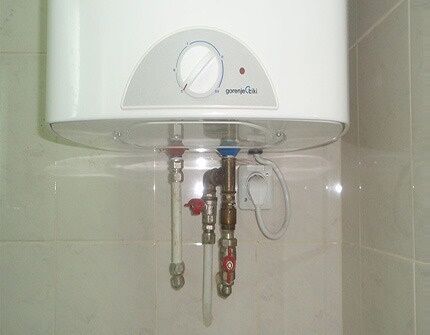
Improved standard connection type
It is very convenient when the tee is placed on both sides - at the inlet of cold water and the outlet of heated water.
With this type of piping, work is carried out in the following sequence:
- Turn off the tap at the water inlet to the device.
- Put on the drain hose.
- Open the faucet to release the pressure inside the container and drain the remaining water in the hose.
Direct the drain hose into the sewer or prepared container and turn the air supply valve on the tee to the open position.
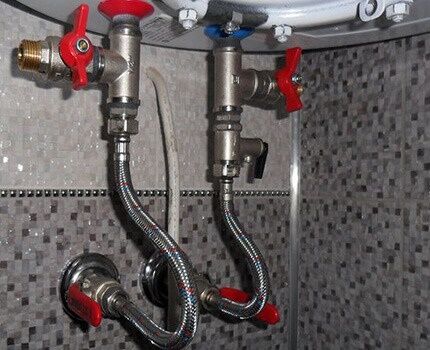
A simplified way to connect a boiler
Simplified, this method can only be called from the point of view of the employee who implements it. It will create a lot of inconvenience for the user of the device.
The procedure for draining water goes like this:
- Stop the water supply to the device.
- Open the faucet and drain the remaining warm water from the hose.
- Open the flag on the safety valve and drain the water.
The difficulty is that the water will take a very long time to drain, since in order to drain it, it is necessary for air to enter the container. It will not flow well from the mixer. Or it won't happen at all. The problem is solved by removing the hot water pipe. You need to twist it carefully so as not to damage the thread.
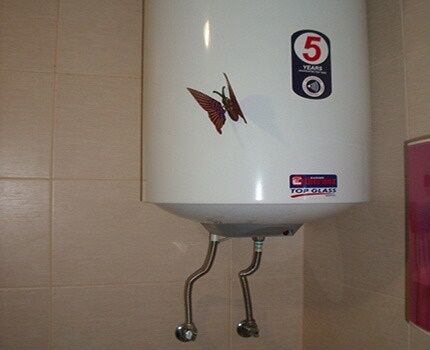
To make the process much easier the next time you drain the water, take advantage of the fact that the boiler piping has been disassembled and reassemble it correctly.
With any connection, some deviations from the standard diagram are possible. Firstly, the shut-off valve, which is installed to shut off the supply of warm water to the mixer, may be missing.
In this case, while water from gas or electric boiler drains, it is necessary to ensure that none of the family members use the water supply, otherwise water will begin to flow through the mixer into the boiler, filling it.
Secondly, the real problem can be the absence of a flag that opens the drain on the safety valve.
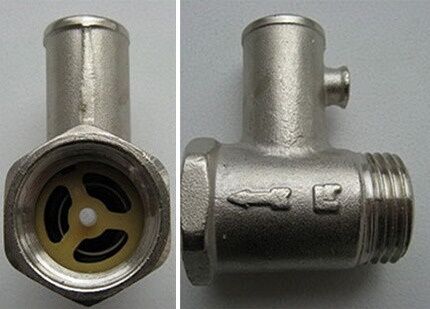
So as not to shoot safety valve from the water heater, you will have to hold the spring (see picture) as long as the water flows.
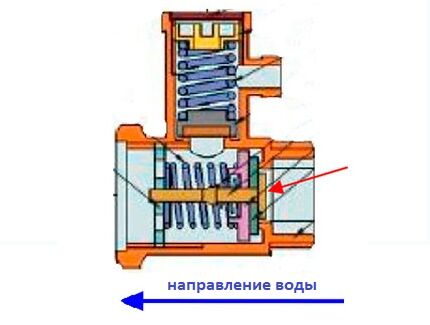
Emergency water removal
If you don’t have time to wait until the water from the water heater gradually drains or the relief valve does not work, there is a way to do it much faster.
Actions are performed in the following sequence:
- Shut off cold water. If there is no water supply tap to the boiler, then the water supply is shut off at the entrance to the apartment.
- The valve at the outlet of warm water from the heater is opened, and the internal pressure is compared with the external one. Then the tap is closed.
- If the water heater does not hang above the bathtub, use a bucket or deep basin.
- Disconnect the warm water hose.
- Unscrew the tee with the relief valve (we repeat, this should only be done if the relief valve does not work or if you need to drain the water very quickly).
All that remains is to have time to change containers on time. To stop the flow of water while replacing containers, shut off the air flow into the heater.
Draining residual water from an electric boiler
The design of the boiler is such that no matter how carefully you try to drain the water, a certain amount of liquid, and with it sediment, will remain inside.
Let’s consider further how to drain all the water from the water heater without any residue:
- Drain off the bulk of the water using one of the methods described above.
- Unscrew the decorative cap, which is located at the bottom of the tank.
- Holding the cover, disconnect the signal lamp wiring.
- Disconnect the electrical wires. To reattach them correctly, you can take a photo of their original placement.
- Next, slowly, counterclockwise, unscrew the flange, which serves as a support for tena, first simply loosening the nuts and allowing the remaining water to gently drain from the tank, and then unscrewing it completely.
- Take out heating element slowly, being careful not to damage it and the tank.
Please note that a heating element may become overgrown with scale, which will prevent it from leaving the container. Therefore, if, when removing the heating element,A resistance is felt, remove it carefully, moving it left and right.
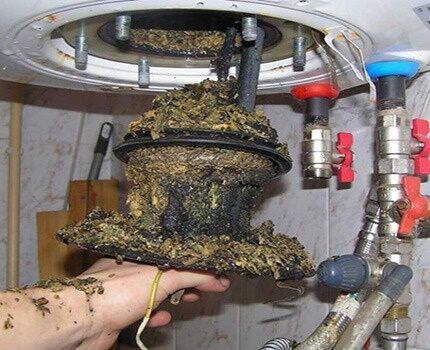
If you had to drain the water from the boiler, you will also have to clean it at the same time. After removing the flange and removing tena there will be no doubt about it.
General rules for disassembly and washing
If there is a lot of sediment in the tank, some of it can be removed manually. Before this, remove the rubber gasket, which serves as an insulator between the flange and the water heater tank. It should also be cleaned.
The inner walls and bottom are washed with a hose and water. You can connect cold water to the hot water outlet. Inside the water heater, the tube for drawing heated water reaches to the very top.Water entering the tube is lightly sprayed and washes the inner walls of the container. They run the water in several stages and clean out debris from the bottom.
If after washing there is an unpleasant odor in the container, you can treat it with a vinegar solution. A sponge soaked in vinegar is attached to a long stick and the internal surfaces are wiped.
Cleaning the heating elementA happens manually first. Using a screwdriver or knife, remove the top loose layer of plaque. Anything that is not removed will be removed after soaking the heating element in citric acid.
To do this, make a hole in a plastic bottle slightly larger in diameter than the size of the heating element.A. Pour hot water into it and add citric acid (you can use vinegar). Leave for a day, stirring the solution from time to time or replacing it with a new one.
At the end of the specified period heating element remove and easily remove softened scale. This can be done using a wooden or plastic spatula.
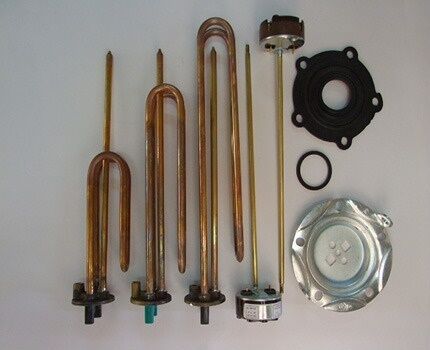
Reassemble the boiler in the reverse order and turn on the water. Before connecting the device to the electrical network, it is checked for leaks.
Conclusions and useful video on the topic
Video #1. Once again about draining water with a standard connection of an electric water heater:
Video #2. What to do if there is no drain flag on the safety valve:
Video #3. A quick way to drain water from a water heater:
Like any device that comes into contact with water, an electric water heater requires special care.Corrosion, oxidation of threaded connections, scale and downtime can lead to the device serving much less than the period stated by the manufacturer. That’s why proper operation and timely preventative maintenance are so important.
Would you like to tell us how you yourself drained water from a water heater for conservation, cleaning or repair? Did you find any controversial issues while reading the information presented? Please write comments and ask questions in the block below.




I recently cleaned my water heater and, to be honest, while I was thinking about blowing into the air intake valve, I was waiting for the water to flow out in a thin stream. But patience is not ironclad and I decided to speed up the process and had to think, but here everything is already collected and written. Now I regret that I didn’t go on the Internet and read a hundred and how to do it. In general, everything is quite easy when you know what awaits you and what to do. Keep at it and everything will work out!
Mechanical cleaning of the heating element, which is recommended here, is not the best option for removing scale. Still, the old heating element has already corroded and its walls are thinner than the new one. Damaging such a heater is as easy as shelling pears. I would recommend chemical cleaning, with citric acid or vinegar, or replacing the heating element with a new one. The heating elements in water heaters are thin and have a short service life.
But I don’t understand the phrase: “...The heating elements in water heaters are thin, their service life is short.”
Two years ago I bought an apartment on the resale market. There is a boiler installed in the bathroom and it has been standing for a long time. According to the first owner of the apartment, the boiler has been installed for 17 years. Naturally, no one cleaned it.I won’t risk opening and cleaning it either; let it work as long as it has left.
I use the boiler only in the summer, when the hot water supply is turned off. But it became necessary to drain the water and remove the boiler in order to make repairs in the bathroom (replacing tiles). There is no drainage system on the boiler; the valve has become slagged over time and the moving parts are jammed. It seems clear how to drain the water, but at the same time I want to change the fittings at the inlet. Are there any nuances?
Hello, Nikolay. Firstly, the thickness of the heating element has virtually no effect on its service life. The service life is more influenced by the quality of the water, as well as the build quality of the boiler itself.
As for the fittings, you can install exactly the same ones as you had before. If you need a more modern implementation, then you will need the following components:
1. Filter;
2. Pressure regulator;
3. Shut-off valve, 2 pcs.;
4. Tees;
5. Ball valve for draining;
6. American, 2 pcs.
For clarity, I am attaching a detailed connection diagram. Consumables will cost you about 1000 rubles.
As for connecting the water heater to the network, it is better to implement it through a separate machine. If this has not been done previously.
I have just such a problem - there is no tap for draining. You have to turn off the return line and wait until the water drains from the boiler in a thin stream. And this is a long time. And the water doesn’t drain completely, at least it didn’t work for me. Maybe I'm doing something wrong, of course, but there is still some water left in the tank. It’s good that the tank itself is located above the sink and the residues drain clearly into it.
I'm shocked.I thought running water would make life easier for me at the dacha, but it turned out I found a problem on my own. I will never be able to do all this - considering that there is no man in the house... hmm... I still have to clean it all ((((And this is not a city, there are no plumbers at the dacha.
It is not clear why such difficulties? And most importantly, no one can say whether there is water left in the tank or not, and if so, how much. Apparently it’s very difficult to come up with such a device, but in reality it’s “woman conjures, grandfather conjures”, one drains this way, the other that way... Nonsense!
Yes, everything is much simpler. I drain by manipulating only the taps!
You open a cold water tap in the kitchen, for example. Naturally the water will not flow. We open the hot water tap in the bathroom if there is a “one-arm” mixer tap. We simply blow air into the boiler with our mouth through the hot tap, creating a preliminary slight pressure. You can blow into a cold tap. Air bubbles will enter the tank when it is closed and hot. We place a container under the cold tap and the water has nowhere else to go, it will flow, and through the hot open tap the tank will begin to fill with air at atmospheric pressure, displacing water from it. Use it. I always leak like this...